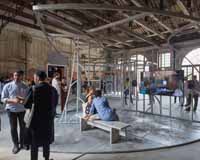Contact Center
.
28 May 2016
Kingdom of Bahrain’s National Participation at the 15th International Architecture Exhibition "La Biennale de Venezia- Arsenale"


For the fourth consecutive time, the Kingdom of Bahrain has attended another rendezvous with the big international architectural meeting, Venice Biennale. ‘Places of Production- Aluminum’ is the Kingdom of Bahrain’s National Participation at the 15th International Architecture Exhibition- La Biennale de Venezia. The pavilion, located at the Arsenale Artiglierie in Venice, was commissioned by Her Excellency Sh. Mai bint Mohammed Al Khalifa, president of the Bahrain Authority for Culture & Antiquities and inaugurated on 27 May 2016.
Bahrain Venice Biennale Pavilion is centered on a detailed explanation of aluminum extraction and the possibilities of its use. Known since the Dilmun times, this precious metal offers unlimited modern inspirational compositions and shapes. The title chosen by Alejandro Aravena for the 15th International Architecture Exhibition is ‘Reporting from the Front’.
Speaking for the occasion, H.E Shaikha Mai said, “Every time we participate in Venice Biennale, we open a window on the world and offer the opportunity to discover our universal ancient architectural heritage that gives cities an identity, old in time and modern in tendency.” H.E argued that selecting an aluminum theme this year comes as part of a universal trend that seeks to offer the best ways to form and build urban fabrics of which aluminum plays a central role.
H.E Shaikha Mai added saying, “Participation in international events, such as 2010 Venice Biennale, as the first Arab country and Golden Lion Award, contributes to the bright image of Bahrain in the world. Today, from the heart of our pioneering international aluminum industry stronghold, we salute the relentless efforts of creative captains of industry who have built a strong economy and an open-minded culture which has become a model in the world.”
Designed by Architect Noura Al-Sayeh and Bahrain Authority for Culture & Antiquities architect Anne Holtrop and realized by Anne Holtrop studios, the Bahraini Aluminum Pavilion, which is made out of sand casted aluminum, differs from the standard use of aluminum through extrusion profiles or sheets, as the real characteristics of the material becomes visible through the roughness and variety of shades.
‘Places of Production- Aluminum’, Bahrain’s pavilion, highlights the history of Alba through a series of photos by Armin Linke and Giulia Bruno who documented the chain of production from its beginnings until the metal’s production in “Jaramco”.
In addition, Venice Biennale Bahrain’s pavilion also features a number of photos of Bahraini buildings taken by photographer, Camille Zakharia, showing the increased spread of aluminum metal in the Bahraini architecture. This new tendency to use aluminum in every facet of modern life was depicted by journalist Ali Karimi. Another corner of the pavilion is devoted to aluminum smelter in Holland and its sandy black aluminum alloys.
The photography exhibition is accompanied by a study conducted by the Ports Research Group, based in Bahrain, on the impact of the aluminum industry in Bahrain through a series of urban and industrial plans, the world price markets with regard to this industry and a press review of the major media complain in the newspapers during the 1970s and 1980s. The study shows how the “enthusiastic discourse” heralded a new dawn for modern Bahrain’s industry with the aluminum era.
The first aluminum smelter in the Gulf region was inaugurated in 1968 in Bahrain and is today the fourth largest single-site smelter in the world. It continues a history of metal trade that finds its roots in the third millennium BC when the islands were at the crossroads of the regional trade route for copper and tin. The smelter was initiated as an effort to diversify the economy away from its reliance on oil by broadening the industrial infrastructure although incidentally relying heavily on the oil industry and its byproducts. At roughly the same time, standardised products of construction, such as window frames, cladding panels and others, also made their entry into the island and progressively infiltrated all aspects of the construction process. Today, aluminium cladding of high-rises and towers, and increasingly in the re-cladding of older facades, is one of the most visible expressions of contemporary architecture in Bahrain.
The presence of the smelter also developed a local economy of aluminum, both formal and informal. Alongside large locally-based international companies producing typical byproducts of aluminium, smaller workshops have developed with a focus on a smaller-scale production of aluminium. Through an investigation of the gestures in the production processes of aluminium, the installation in the Arsenale, using film, photography and sand-casted aluminium, is an attempt to extract a different potential of the material use.
The 15th International Architecture Exhibition, titled ‘Reporting from the Front’ includes 63 national participants in the historic pavilions at the Giardini, at the Arsenale and in the historic city center of Venice. Four countries will be participating for the first time: Philippines, Nigeria, Seychelles and Yemen. This is the 4th Bahraini participation in Venice Biennale after, ‘Reclaim’, Bahrain's first participation at the 12th Venice Architecture Biennale in 2010, which was awarded the Golden Lion for best national participation, ‘Background’, Bahrain's second participation at the Venice Architecture Biennale in 2012 and Bahrain’s third pavilion ‘Fundamentalists and Other Arab Modernisms’.







